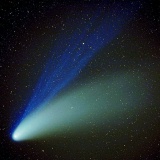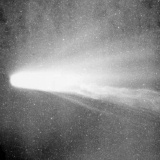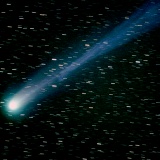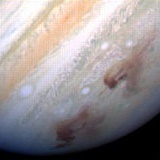 |
|
|
Comet Hyakutake visits the inner Solar System once
every 14,000 years.
|
|
| COMETS | |
| Usually comets are very small bodies consisting of frozen gases and grains of dust and rock. It is when comets approach the inner Solar System and become subjected to the Sun's heat, that they develop a tail millions of kilometres long and thus become very large objects. | |
| Many comets remain too faint to be seen with the naked eye, but a few become so bright and spectacular they dominate the sky and enter the historical record. Comets have been known to civilisations for thousands of years, and were often regarded as messengers of doom or upheaval. | |
| Cometary orbits | |
| Comets have very elliptical orbits - they come very close to the Sun, and then travel to the outer Solar System. Nor are their orbits restricted to the plane of the Solar System - they come in at a variety of angles. | |
| Comets can be differentiated into short-period and long-period orbits. Short-period comets have periods of less than 200 years, whereas long-period comets can take up to a million years to complete just one orbit of the Sun. This implies that long-period and short-period comets have a different source. Current thinking is that short-period comets reside in a belt - the Kuiper Belt - located between 4000 million and 7000 million kilometres from the Sun. Long-period comets are proposed to come from the Oort Cloud, at a distance of 3 million million kilometres. This distance is more inter-stellar than planetary. | |
| More about the Oort Cloud and Kuiper Belt | |
| Nucleus and coma | |
| The nucleus of a comet is usually very small, in the region of 10 kilometres across. The nucleus is similar to a dirty snowball, a mixture of frozen water, frozen gases, and grains of dust and rock. When at aphelion, temperatures are so low there is no evaporation from the nucleus at all. At such great distances the Sun appears as a bright star, and provides no heat to the cometary nucleus. Reflected sunlight is minimal, and the comet cannot be seen. | |
| As the comet swings towards the inner Solar System, the Sun starts to heat the nucleus, which develops a surrounding diffuse cloud as the surface material begins to evaporate. The cloud is known as the coma, and when a comet is in this state it starts to become visible to major telescopes. This process starts to occur when the comet is within 500 million kilometres of the Sun. As well as reflecting sunlight from the larger coma, the comet also reacts to the Sun's ultraviolet radiation by fluorescing. Fluorescence becomes a greater light source than the reflected sunlight, and this is why many comets are first detected when they have produced a coma. | |
 The nucleus of Halley's Comet, and the surface sources of the coma, as seen by the Giotto spacecraft. |
|
| Tails | |
| As the comet continues its journey into the inner Solar System, it falls more and more under the influence of the solar wind. The solar wind forces the material surrounding the nucleus, the coma, away from the comet to form a tail with a length measured in millions of kilometres. In fact, two tails are formed by the pressure of the Sun's wind and radiation. One tail consists of the more massive material, dust, and as this material accelerates slowly it forms a tail that is curved. The second tail consists of ionised gases (where electrons have been stripped from the atoms). The second tail has a lower mass and is accelerated away from the nucleus more rapidly. The ion tail is therefore straighter than the dust tail | |
 The two tails of comet Hale-Bopp - the straighter ion tail at the top, and the curved dust tail below. |
|
| Halley | |
| Most people will regard Halley as the most famous comet of all. With an orbital period of 76 years, Halley has been visiting the inner Solar System on a regular basis for at least two thousand years, but each visit was regarded as a different comet. | |
 The most famous comet of all - Halley's comet. |
|
| More about Halley's comet | |
| Hale-Bopp | |
| Hale-Bopp put on one of the best shows of the 20th century, easily visible to the naked eye the world over. Hale-Bopp's orbits every 4000 years. | |
 The coma and dust tail of comet Hale-Bopp. |
|
| More about Hale-Bopp | |
| Hyakutake | |
| Hyakutake visits the inner Solar System every 14,000 years, the most recent being 1996. | |
 Hyakutake's close approach to the Sun generated a very long tail. |
|
| More about comet Hyakutake | |
| Shoemaker-Levy hits Jupiter | |
| One of the most widely observed astronomical events occurred in 1994 when the comet Shoemaker-Levy 9 impacted Jupiter. The impact was observed by virtually every major telescope facility, as well as the orbiting Hubble Space Telescope and even the Galileo spacecraft. | |
 Hubble Space Telescope view of the Shoemaker-Levy crash site. |
|
| More about Jupiter and Shoemaker-Levy 9 | |
|
|
|